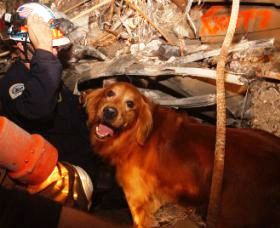By Linda Cole
Some dogs are just naturals at searching for people who have become lost in the wilderness or buried under rubble or snow. In London during WW II, dogs that had never been trained in search and rescue (SAR) found people buried in debris after bombing raids destroyed their city. Dogs have been by our side for centuries helping us locate those in need. However, along with proper training, there are specific qualities a good SAR dog needs to reliably aid his human handler. Like people, some dogs aren't suited for rescue work.
Last year, Suzanne Alicie introduced us to Scout, an avalanche rescue dog in the CANIDAE Special Achievers program. Like all search and rescue dogs, Scout has the training and qualities needed to locate his victims. Scout is a purebred Chocolate Labrador retriever, but a good search and rescue dog can be any breed – purebred or mixed breed. The pedigree of a dog isn't important, but their character is.
Man has been using dogs to search for lost souls for centuries. Barry the Great Saint Bernard lived with monks during the early 1800s, at a hospice that had been built in a mountain pass to give refuge to people crossing over the Alps between Switzerland and Italy. Barry, along with a team of dogs, patrolled a 49 mile route used by people traveling through the pass. The dogs could smell someone buried under snow and were trained to sniff out and rescue travelers who had become lost or stranded in the mountains.
The dogs proved to be so capable of working without the monks that they were sent out on their own in groups of two or three to patrol the area. One or two dogs stayed with the victim, lying on them to keep them warm while the other one raced back to the hospice for help. Barry is famous as the dog with the most rescues. These dogs were the early version of today's Saint Bernard. The breed was named after the Augustine monk who established the hospice, St. Bernard de Menthon.
The dogs trained by the monks possessed the same qualities then as do today's search and rescue dogs – hard working, dedicated, well socialized with people, strong, smart and a good nose. A SAR dog must be able to cover all kinds of terrain or debris and have the stamina to handle distance and the time needed to complete the job. He must be intelligent, agile, have good balance and strong legs for digging, jumping or climbing.
Search and rescue dogs must be confident, friendly and outgoing. They can't be bothered by loud or sudden sounds, and must be able to get along well with other dogs and people. A good rescue dog is focused and ignores distractions. A strong work ethic is essential in rescue work, but to the dog, it's not work – it's a game they love to play. Too many times during a rescue operation, the victim is out of sight and it's essential for the dog to have an excellent nose and a willingness to listen to their handler.
A good search and rescue dog can be male or female; there is no advantage to one or the other. Newfoundlands make the best search dogs for water rescues, while dogs from the herding, sporting or working groups are generally regarded as being the best breeds for rescue work on land. However, any breed or mixed breed that weighs at least 50 to 70 pounds can be trained to do this grueling work. Although smaller dog breeds are not typically used in search and rescue work, some can be capable of it. In London during WWII, a wired-haired terrier was used to search bombed out buildings for people and animals that had been trapped inside. Her name was Beauty, and because of the many human and animal lives she saved, Beauty received the Pioneer Medal that normally was only given to humans. Beauty also received the Dickin Award, the highest honor given to animals for bravery which is equal to the Victoria Cross.
Without the help of well trained search and rescue dogs, many souls would have been lost. We owe these exceptional dogs and the people who work with and train them, our gratitude for the job they do. CANIDAE understands the commitment it takes for SAR dogs and their handlers who risk their lives to save those in need. Their Special Achievers program was created to support these extraordinary canines and others like them – dogs that make a difference in the lives of many. You can read about Scout and other Special Achievers on the CANIDAE website.
Read more articles by Linda Cole
Qualities of a Good Search and Rescue Dog
Labels:
canidae,
Linda Cole,
search and rescue dogs,
Special Achievers

